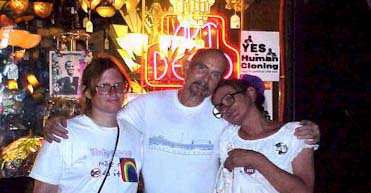 and Death-Legendary Figure Dies at 50 Colorful Pioneer of the Stonewall Era Crusaded until the End Had 'Finally Gotten Her Life in Good Shape' say Old Friends |
|
By Randolfe H. Wicker
This was no small achievement for someone whose mother had tried to take Sylvia with her in a double suicide because she feared Sylvia (whose given name was Rey Rivera Mendoza) would "have a hard life". At eleven, with only five years of schooling, Sylvia found herself working Times Square and 42nd St. as a transvestite child prostitute. In that environment, she would meet Marsha P. Johnson, another legendary figure, who became her mentor and role model. During the tumultuous years following 1969, Sylvia would be an active member of GLF and GAA. However, she always considered her efforts with Marsha P. Johnson and others in establishing the first refuge for transgendered youth in East Village as the apex of her activist career.. They called their group "Street Transvestite Action Revolutionaries" and their tenement headquarters " S.T.A.R. House" Sylvia Rivera's favorite garment in recent years was a black sweater with a rainbow star knitted into it. Sylvia lived a life of activism. Wherever and whenever there was an injustice, she would join with those demonstrating about it. When some angry Blacks who were marching to protest the brutalization of Abner Louima started calling NYPD officers "faggots", Sylvia quickly reminded them that a lot of gay people were there supporting their protest. The shouts of "faggot cops" ceased.. When the memorial march commemorating Matthew Shepherd took to Fifth Avenue, the officer in charge reportedly pointed at Sylvia and instructed his underlings "to get that one" because "she is a real troublemaker" When stopped from entering Central Park attempting to give out memorial badges emblazoned "Clone Diana: One Good Lifetime Deserves Another" the police recognized her immediately and addressed her by name, asking her to calm down so they wouldn't have to arrest her. Sylvia believed in the cloning of organs, kidneys and livers, but participated in the first demonstration in support of human cloning mainly out of a sense of comradeship and solidarity with me. Sylvia had serious reservations about (and even opposed) reproductive cloning because she believed it would be something available only to the wealthy. During the 2000 Millennium Celebration in Rome, Italy, Sylvia Rivera and Julia Murray were treated like royalty. Housed in a castle, Sylvia was given tribute as the founder of the World's Struggle for Transgendered Rights.
 Sylvia Rivera, right, and her love Julia Murray with GayToday's editor (center) celebrating in 1999 those 30+ years that have passed since New York's Stonewall uprising She continued high profile activism literally on her deathbed at St. Vincent's Hospital. Hours before she died, Matt Forman (who previously worked for the Empire State Pride Agenda) visited the St. Vincent's Hospital and heard her plea for inclusion of transgendered people in proposed legislation currently being considered by New York State legislators. On February 7th, Sylvia Rivera, obviously in frail health, had spoken at a rally held outside that group's offices protesting the exclusion of transgendered people from the proposed civil rights legislation. "Sylvia looked like she really shouldn't have been there," one activist commented after the well-attended event ended. It was obvious to those around her that Sylvia's time was running out. In the final weeks, with jaundiced skin, unable to sleep for days on end because of the pain caused by the cancerous tumor in her liver, Sylvia continued to supervise the food distribution to the homeless and the HIV clients at the Metropolitan Community Church's food pantry on West 36th Street in Manhattan. The Subways had become too difficult. She continued to show up for work even though the cab fares to and from "Transy House" in Brooklyn consumed much of her pay. She had lived for several years in a house owned by a transgendered couple that shared their home with other transgendered people.
The fight to get a permit for a horse drawn carriage in Manhattan from the newly elected Republican Mayor, the problem of getting access to the Hudson River waterfront so Sylvia Rivera's ashes could be scattered near where she once lived in a gay homeless encampment and/or near the foot of Christopher Street (technically an illegal act) where she had helped scatter the ashes of her dear friend and Patron Saint, Marsha P. Johnson, was a legendary activist's final challenge left to her legions of admirers and friends. |


